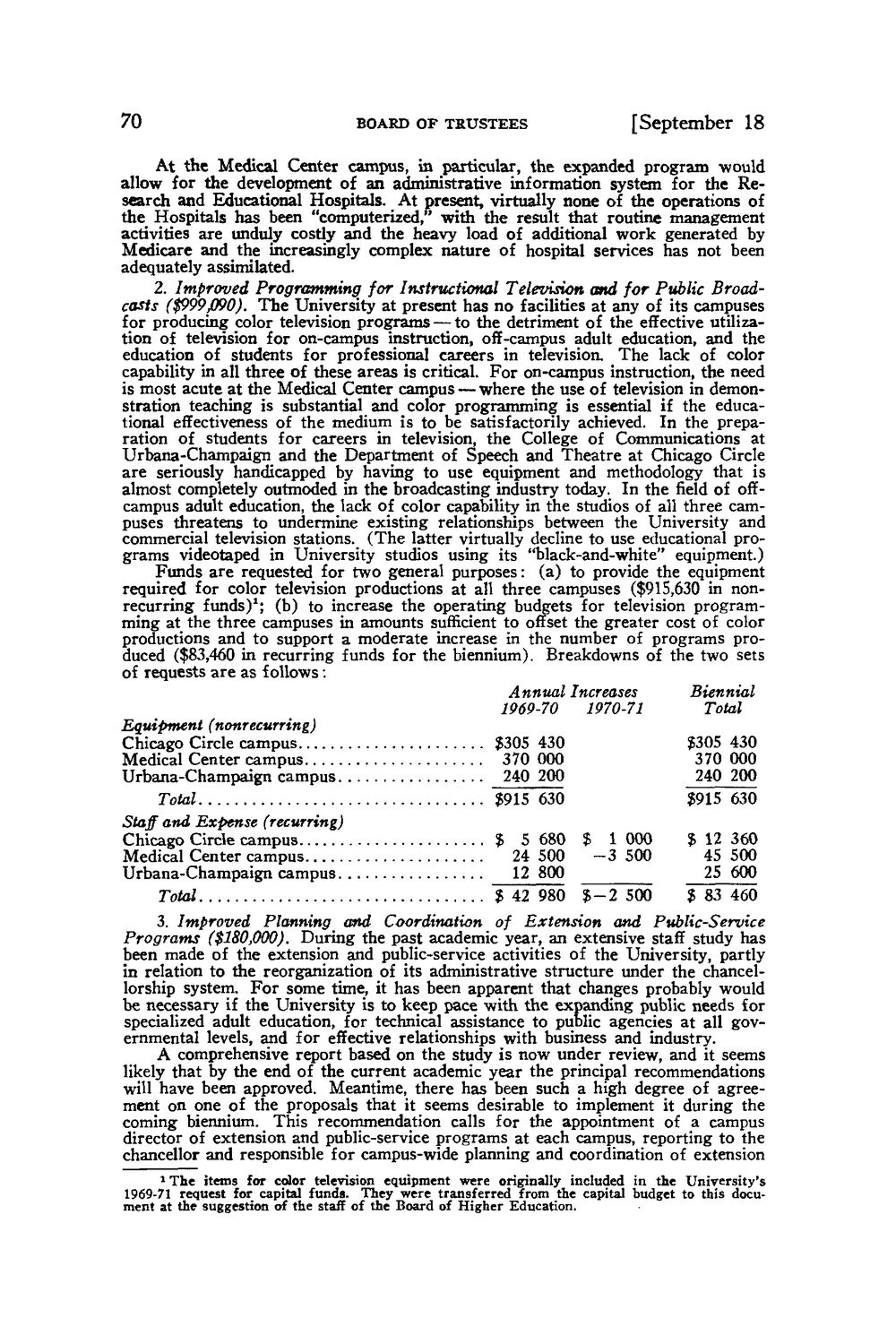| |
| |
Caption: Board of Trustees Minutes - 1970
This is a reduced-resolution page image for fast online browsing.

EXTRACTED TEXT FROM PAGE:
70 BOARD OF TRUSTEES [September 18 At the Medical Center campus, in particular, the expanded program would allow for the development of an administrative information system for the Research and Educational Hospitals. At present, virtually none of the operations of the_ Hospitals has been "computerized," with the result that routine management activities are unduly costly and the heavy load of additional work generated by Medicare and the increasingly complex nature of hospital services has not been adequately assimilated. 2. Improved Programming for Instructional Television and for Public Broadcasts ($999090). The University at present has no facilities at any of its campuses for producing color television programs — to the detriment of the effective utilization of television for on-campus instruction, off-campus adult education, and the education of students for professional careers in television. The lack of color capability in all three of these areas is critical. For on-campus instruction, the need is most acute at the Medical Center campus — where the use of television in demonstration teaching is substantial and color programming is essential if the educational effectiveness of the medium is to be satisfactorily achieved. In the preparation of students for careers in television, the College of Communications at Urbana-Champaign and the Department of Speech and Theatre at Chicago Circle are seriously handicapped by having to use equipment and methodology that is almost completely outmoded in the broadcasting industry today. In the field of offcampus adult education, the lack of color capability in the studios of all three campuses threatens to undermine existing relationships between the University and commercial television stations. (The latter virtually decline to use educational programs videotaped in University studios using its "black-and-white" equipment.) Funds are requested for two general purposes: (a) to provide the equipment required for color television productions at all three campuses ($915,630 in nonrecurring funds) 1 ; (b) to increase the operating budgets for television programming at the three campuses in amounts sufficient to offset the greater cost of color productions and to support a moderate increase in the number of programs produced ($83,460 in recurring funds for the biennium). Breakdowns of the two sets of requests a r e as follows: Annual Increases Biennial 1969-70 1970-71 Total Equipment (nonrecurring) Chicago Circle campus $305 430 $305 430 Medical Center campus 370 000 370 000 Urbana-Champaign campus 240 200 240 200 Total $915 630 $915 630 Staff and Expense (recurring) Chicago Circle campus $ 5 680 $ 1 000 $ 12 360 Medical Center campus 24 500 - 3 500 45 500 Urbana-Champaign campus 12 800 25 600 Total $ 42 980 $ - 2 500 $ 83 460 3. Improved Planning and Coordination of Extension and Public-Service Programs ($180,000). During the past academic year, an extensive staff study has been made of the extension and public-service activities of the University, partly in relation to the reorganization of its administrative structure under the chancellorship system. F o r some time, it has been apparent that changes probably would be necessary if the University is to keep pace with the expanding public needs for specialized adult education, for technical assistance to public agencies at all governmental levels, and for effective relationships with business and industry. A comprehensive report based on the study is now under review, and it seems likely that by the end of the current academic year the principal recommendations will have been approved. Meantime, there has been such a high degree of agreement on one of the proposals that it seems desirable to implement it during the coming biennium. This recommendation calls for the appointment of a campus director of extension and public-service programs at each campus, reporting to the chancellor and responsible for campus-wide planning and coordination of extension 1 The items for color television equipment were originally included in the University's 1969-71 request for capital funds. They were transferred from the capital budget to this document at the suggestion of the staff of the Board of Higher Education.
| |